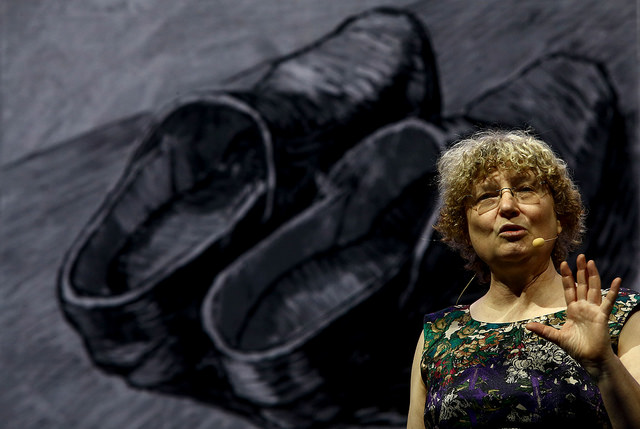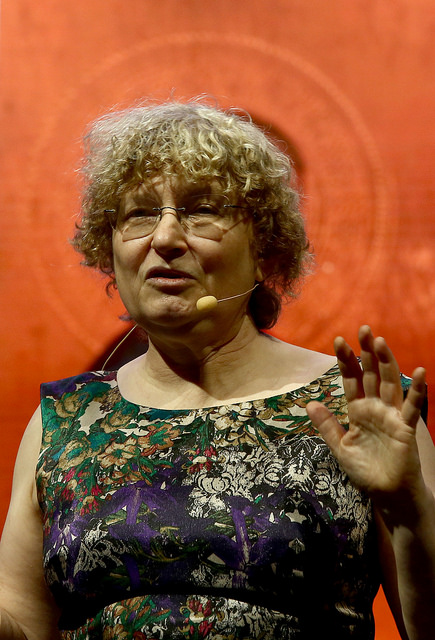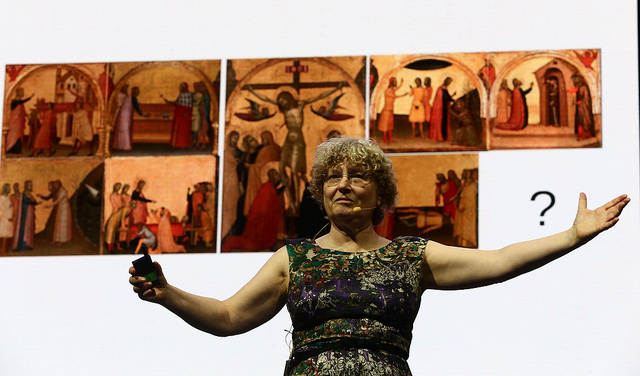August 3, 2018, 8:29 pm

If one of the greatest pleasures in life is the feeling of really helping others, Ingrid Daubechies must be one of the happiest people at ICM 2018. Her work in pure mathematics has been applied to various fields including image compression, data storage, paleontology and even in the restoration of classic works of art.
Ingrid studied physics in Brussels before marrying American mathematician, Robert Calderbank, who she met during his three-month exchange from AT&T Bell Laboratories in New Jersey, USA. After moving to the States, Ingrid started making significant discoveries in the field of wavelets, studying mathematical structures perceived as kinds of waves. She discovered there are various types of wavelets, the characteristics of which she was able to describe in her classic 1992 publication: Ten Lectures on Wavelets.
Read more:
Keen that her work applies outside the field of pure mathematics, Daubechies’ breakthrough was used in the creation of JPEG2000 standard, the format for storing digital images. Her specific mathematical formulae enables data to be compressed and stored much more efficiently. The FBI was one of the first to utilize the new technology in streamlining the storage of fingerprint data.
The former IMU President described her achievements in the world of art history at a public lecture at ICM 2018. Daubechies presented stunning examples of how her work in image analysis has been used to restore, rejuvenate and uncover lost works. She explained how, along with Massimo Fornasier, entire frescos from a church in Padua, Italy were restored, having been heavily bombed during the Second World War.
After the war was over, local art historians and conservators faced the daunting task of trying to piece together over 80,000 fragments of painted stone, which formerly covered over 800 square meters of an interior wall inside the church. A seemingly impossible task. The pieces had lain in storage for decades, and teams had almost given up hope of reconstructing the work as only around 2% of the originals remained, with the rest reduced to rubble.
Presented with the problem, Ingrid used one of her favorite phrases: Math can help!’ The pieces had been digitized and stored on computers in the 1990’s, but at the time neither the computing power nor techniques were available to get to conquer the project.

Using a record of black and white photographs, Ingrid and her team set about digitizing the images of the original frescos into hued pixels from brilliant white 0 to jet black 255. Ingrid boasts that some people have 50 Shades of Gray,’ but her digital analysis has 254.
Using a process of circular harmonics to work out the orientation of the fallen pieces, matches were identified and digitally mapped onto existing black and white photos. The complete color originals were then propagated from the fragments.
This incredible technology has also been used to recreate missing works. The Ghissi altarpiece which tells the story of John the Evangelist, painted in the 14th century, was removed from its home in Italy and the various panels sawn apart. The panels would wind their way to various museums and collections in the US. Curators wanted to bring together the nine panels of this great religiously-inspired masterpiece, but somewhere along the line, the final scene had gone missing.

Ingrid, along with Belgian artist, Charlotte Caspers, started to work on recreating the lost panel. They found the story of John the Evangelist in medieval best-seller – ‘Golden Legend’ – which gave them the scene to paint. Charlotte took the stylistic elements from the other panels and with painstaking detail, produced a faithful reconstruction. It was perfect. However a new problem arose – the new panel was so vivid that it didn’t fit with the other original pieces. Once again, Ingrid’s mantra: “Math can help”.
Analyzing colors on the original panels, and applying Ingrid’s mathematical technology , the new image could be digitally-aged to fit in. But, the team realized they could reverse the process and restore the originals to their former brilliant glory.
The final exhibition contained the original with the digitally-aged recreation of the missing panel, a restored print of the altarpiece how it would have looked 600 years ago and a digital video demonstrating the glory of the original with its reflective gold leaf paint and ornate patterns. The perfect marriage of math and art – a collision of beauty and logic.